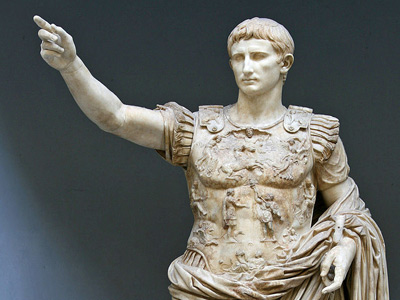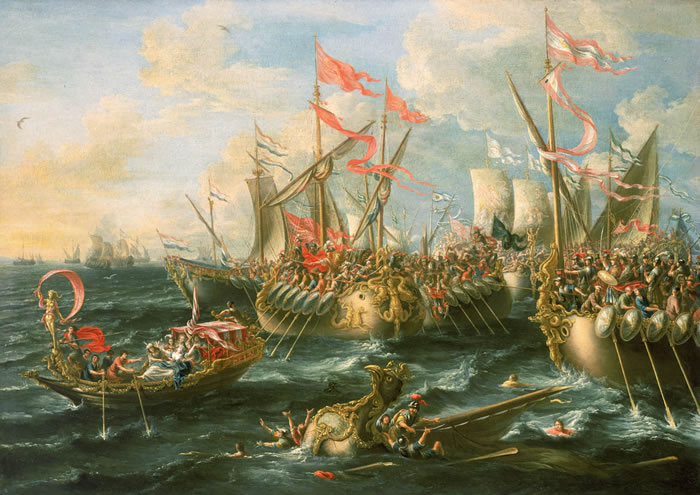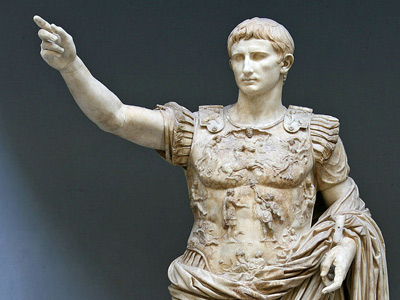Final War of the Roman Republic (32-30 BC)

Naval Theater
By mid-summer of 31 BC, Antony maneuvered his army into Greece and Octavian soon followed. Octavian brought with him his chief military advisor and closest friend Marcus Vipsanius Agrippa to command his naval forces. Although the ground forces were comparable, Octavian's fleet was superior. Antony's fleet was made up of large vessels, but with inexperienced crews and commanders. Octavian's fleet of smaller, more maneuverable vessels was filled with experienced sailors.

The Battle of Actium by Laureys a Castro. This was the decisive battle of the naval theater.

The Battle of Actium by Laureys a Castro. This was the decisive battle of the naval theater
( Click image to enlarge)
Octavian moved his soldiers across the Adriatic Sea to confront Antony near Actium. Meanwhile, Agrippa disrupted Antony's supply lines with the navy. Gaius Sosius commanded a squadron in Mark Antony's fleet with which he managed to defeat the squadron of Lucius Arruntius and put it to flight, but when the latter was reinforced by Agrippa, Sosius's ally Tarcondimotus - the king of Cilicia - was killed and Sosius himself was forced to flee.
Octavian decided not to attack and risk unnecessary losses. Instead, Octavian wanted to battle Antony by sea where his experienced sailors could dominate. In response, Antony and Octavian engaged in Fabian strategy until the time was right. As the summer ended and autumn began to set in, both Octavian and Antony settled for a battle of attrition. The strategy of delay paid dividends to Octavian, as morale sank and prominent Romans The Roman Republic was a form of government of Rome and the era of the classical Roman civilization when it was run through public representation of the Roman people. Beginning with the overthrow of the Roman Kingdom (traditionally dated to 509 BC) and ending in 27 BC with the establishment of the Roman Empire, Rome's control rapidly expanded during this period - from the city's immediate surroundings to hegemony over the entire Mediterranean world. deserted Antony's cause.
The Roman Republic was a form of government of Rome and the era of the classical Roman civilization when it was run through public representation of the Roman people. Beginning with the overthrow of the Roman Kingdom (traditionally dated to 509 BC) and ending in 27 BC with the establishment of the Roman Empire, Rome's control rapidly expanded during this period - from the city's immediate surroundings to hegemony over the entire Mediterranean world. deserted Antony's cause.
The first conflict of the war occurred when Octavian's general Agrippa captured the Greek city and naval port of Methone. The city had previously been loyal to Antony. Although Antony was an experienced soldier, he did not understand naval combat, which led to his downfall. Antony moved his fleet to Actium where Octavian’s navy and army had taken camp. In what would become known as the Battle of Actium, Antony, on September 2, 31 BC, moved his large quinqueremes through the strait and into the open sea. There, Octavian’s light and maneuverable Liburnian ships drew in battle formation against Antony’s warships. Cleopatra stayed behind Antony’s line on her royal barge.
A devastating blow to Antony’s forces came when one of Antony’s former generals delivered to Octavian Antony’s battle plan. Antony had hoped to use his biggest ships to drive back Agrippa's wing on the north end of his line, but Octavian's entire fleet stayed carefully out of range. Shortly after mid-day, Antony was forced to extend his line out from the protection of the shore, and then finally engage the enemy. Octavian's fleet, armed with better trained and fresher crews, made quick work of Antony’s larger and less experienced navy. Octavian’s soldiers had spent years fighting in Roman naval combat, where one objective was to ram the enemy ship and at the same time kill the above deck crew with a shower of arrows and catapult-launched stones large enough to decapitate a man.
As the armies stood on either side of the naval battle, they watched as Antony was being outmatched by Agrippa. Seeing that the battle was going against Antony, Cleopatra's fleet retreated to open sea without firing a shot, leaving Antony to fight for himself. As a gap opened in Agrippa's blockade, she funneled through, and was soon closely followed by Antony's command ships. The commanders of Antony's land forces, which were supposed to follow him to Asia, promptly surrendered their legions without a fight. Antony retreated to a smaller vessel with his flag and managed to escape to Alexandria. By the end of the day, Antony’s entire fleet would lie at the bottom of the sea and the Roman world had witnessed the largest naval battle in almost 200 years.
HISTORY

RESOURCES
This article uses material from the Wikipedia article "Final War of the Roman Republic (32-30 BC)", which is released under the Creative Commons Attribution-Share-Alike License 3.0.
© Stories Preschool. All Rights Reserved.









